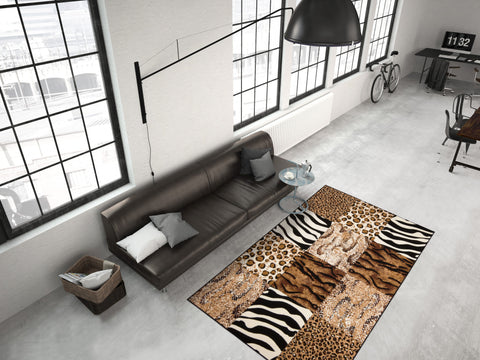How to Use Rugs to Define Different Spaces in an Open Plan Layout

If you live in an open plan home, you might be wondering how to create different zones for different functions without compromising the spacious and airy feel of your space. Open plan living is a popular trend in modern homes, but it can also pose some challenges when it comes to creating a cohesive and comfortable space. How do you separate your living room from your dining area or your kitchen from your home office, without putting up walls or partitions?
One of the easiest and most effective ways to do that is by using rugs! Rugs can help you define different areas, add color and texture, and create a cozy and inviting atmosphere. In this blog, I will share with you some tips on how to use rugs to define different spaces in an open plan layout.
Choose Rugs That Complement Each Other
When you use multiple rugs in an open plan space, you want to make sure they work well together and create a harmonious look. You don't have to match them exactly, but you should avoid clashing colors, patterns, or styles. A good rule of thumb is to choose rugs that share a common element, such as a color, a shape, or a theme. For example, you can use rugs that have similar tones of blue, such as a navy blue rug for the living room and a sky blue rug for the dining room. Or you can use rugs that have geometric patterns, such as a striped rug for the kitchen and a chevron rug for the bedroom. Or you can use rugs that have a bohemian vibe, such as a Moroccan rug for the entryway and a kilim rug for the office.

Use rugs to create boundaries
One of the main purposes of using rugs in an open plan space is to create boundaries between different areas, such as the living room, the dining room, and the kitchen. You can use rugs to visually separate these areas and make them feel more distinct and cozy. For example, you can place a large rug under your sofa and coffee table to create a living room area, or place a smaller rug under your dining table and chairs to create a dining area. You can also use rugs to create pathways or transitions between different zones. To do this you can place a runner rug along the hallway to connect the bedroom and the bathroom, or place a round rug in the center of the space to create a focal point.

Use rugs to add interest and personality
Another benefit of using rugs in an open plan space is that they can add interest and personality to your space. Rugs can introduce color, texture, pattern, and style to your space and make it more lively and attractive. You can use rugs to express your personal taste and style, or to create a mood or atmosphere. For example, you can use bright and colorful rugs to make your space more cheerful and fun, such as a rainbow rug for the kids' play area or a floral rug for the sunroom. Or you can use neutral and soft rugs to make your space more calm and relaxing, such as a beige rug for the reading nook or a sheepskin rug for the fireplace.

Use rugs to enhance comfort and warmth
Finally, using rugs in an open plan space can also enhance comfort and warmth. Rugs can provide cushioning and softness for your feet, especially if you have hard floors like wood or tile. Rugs can also help insulate your space and reduce noise levels, which can be important in an open plan layout where sound can travel easily. Rugs can also make your space more cozy and inviting by adding a touch of coziness and warmth. For example, you can use shaggy rugs to make your space more plush and luxurious, or use wool rugs to make your space more snug and cozy.
I hope you enjoyed this blog and learned some useful tips on how to use rugs to define different spaces in an open plan layout. Rugs are versatile and practical accessories that can help you create a beautiful and functional open plan home. If you are looking for some amazing rugs for your space, check out our website for some great deals and offers!
SHARE:



